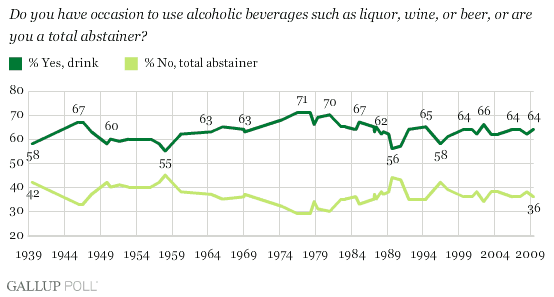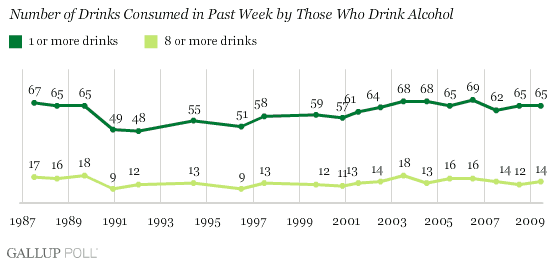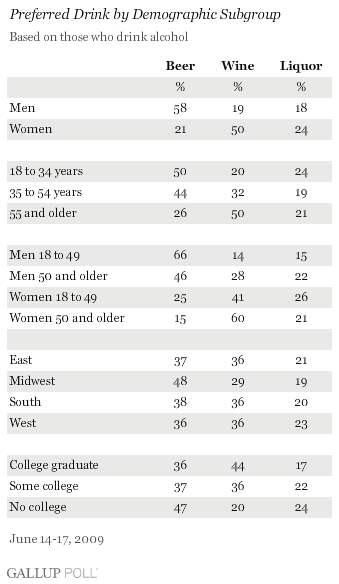PRINCETON, NJ -- Despite some anecdotal reports of a surge in drinking accompanying the economic recession, Gallup's annual update on alcohol consumption finds little change in Americans' drinking habits. The percentage of U.S. adults who consume alcohol is fairly steady at 64%, and there has been little change in self-reported drinking volume.

In fact, the percentage of Americans saying they drink alcohol has been in the low to mid-60s fairly consistently since about 1947. The major exception was between 1974 and 1981, when slightly more Americans (from 68% to 71% for most of this period) said they drank alcohol. Since the advent of the question in 1939, the figure has dipped below 60% on only a few occasions.
About two-thirds of drinkers in the new survey -- 65% -- say they have had at least one drink within the past seven days. This is identical to a year ago, and similar to the finding each year since 2001. The percentage of heavier drinkers -- those consuming eight or more drinks in the past week -- is currently 14%, also quite typical for the decade.

Stability, Also, in Preferred Drink
Nor does it appear that Americans' preferred beverage has changed with the economic times. Beer continues to beat out wine and liquor as the beverage consumers of alcohol say they drink most often. Four in 10 drinkers say they prefer beer, compared with 34% naming wine and 21% liquor.
Beer has been the top-ranking alcoholic beverage for each of the past four years, and every year since 1992 except 2005, when wine edged slightly ahead of it. Liquor has consistently ranked third, named by between 18% and 24% of drinkers.

On Mars, They Drink Beer; on Venus, Wine
The sizable gender gap evident for many years in alcoholic-beverage preferences continues today. The majority of men say they most often drink beer; half of women choose wine. There is also a significant generational difference in preferences, with younger adults favoring beer and older adults favoring wine. As a result, there is a particularly wide gulf between younger men and older women, in terms of drink preferences.
Geographically, beer enjoys its greatest popularity in the Midwest. On the basis of education, wine is far more popular among people with at least some college background than it is among those who have not attended college.

Bottom Line
The impact of the economic recession on alcohol sales is difficult to discern. Consumer spending on alcohol doesn't tell the full story because, according to some reports, Americans may be opting for cheaper wines, liquors, and beers. Thus, flat sales could actually mean higher volume. Also, changes in restaurant and bar sales have to be analyzed in comparison with changes in liquor purchases for home use.
The theory, at least, is that the recession may give people more reasons to drink, but less money to do it with. To the extent this is true, the effect seems to be a wash. Gallup finds no major changes in the percentage of Americans who drink alcohol (now 64%), in how much drinkers consume, or in their preferred drink -- which, by a modest margin, continues to be beer.
Survey Methods
Results are based on telephone interviews with 1,011 national adults, aged 18 and older, conducted June 14-17, 2009. For results based on the total sample of national adults, one can say with 95% confidence that the maximum margin of sampling error is ±3 percentage points.
For results based on the sample of 677 adults who drink alcoholic beverages, the maximum margin of sampling error is ±4 percentage points.
Interviews are conducted with respondents on land-line telephones (for respondents with a land-line telephone) and cellular phones (for respondents who are cell-phone only).
In addition to sampling error, question wording and practical difficulties in conducting surveys can introduce error or bias into the findings of public opinion polls.
